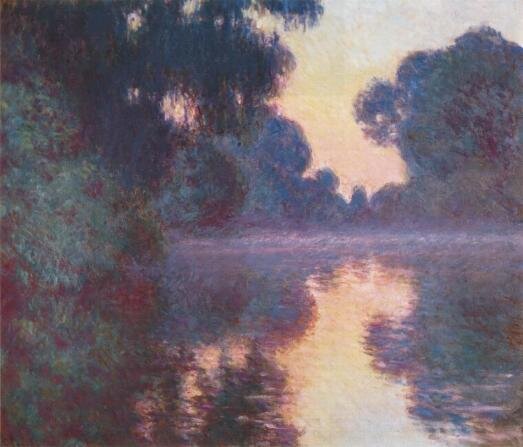MONET’S EPTE RIVER AT DAWN
I like to travel to the other painter's painting sites. Sometimes seeing the context in which the painting was made gives me insight into the work.
When dealing with Monet, going to one of his painting sites may not be enough, unless you also happen to be there during the time of year and hour of day that he worked on his paintings.
And even then, there is much we can't replicate now that Monet was observing in his time, such as the effects of the mini-Ice Age in the 1850s, the pollution from burning coal, and the atmospheric effects caused by the eruption of Kracatoa in 1883.
When I set out to see the Epte River near Giverny, I was at least determined to see it around the same time of day as Monet.
I woke up at four in the morning and ran along the Rue de Roi until I came to a turn off near the location of the old train station. The sun was just beginning to crest over the Colines (hills). I decided to follow the sun.
I found a path through the cow pastures. Soon I found a small shed by the river. If Monet was changing canvases every few minutes, I thought that it would be difficult for him to haul them every morning from his studio.
Could this be a shed that Monet used to store his canvases between painting sessions?
It is also possible that Monet painted his Epte paintings on his studio boat, which blows this theory.
Around the corner from the shed, I came upon this view.
It seemed remarkably like the view in the paintings. I started to take pictures every few minutes. As I stood there several things about Monet's paintings revealed themselves.
I had never understood why the left side of his painting was so much lighter than the right. It seemed to me that it should more closely mirror the right side.
As I stood there I could see that as the sun rose on the left light poured though the trees and dissolved the appearance of the leaves into light. Monet was recording exactly what he was observing.
I shot photo after photo as the light changed.
What became obvious was how quickly the light changed and how everything recorded in Monet's series of paintings of the Epte River basically transpired in an hour.
Each painting shows a phenomena that lasts no more than five minutes. Too fast for him to have recorded it in paint.
It is possible that Monet photographed the scene. He loved photography and housed a darkroom in his second studio. Such photographs could have only been in black and white and no such photos exist today.
However he accomplished these paintings, his power of perception is unrivaled.










